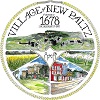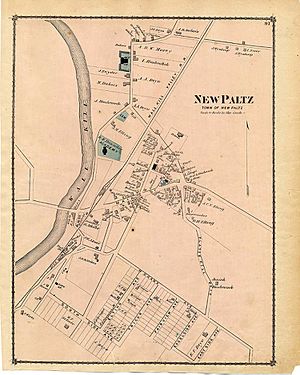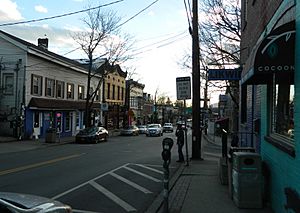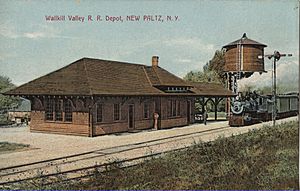New Paltz (village), New York facts for kids
Quick facts for kids
New Paltz, New York
|
|||
|---|---|---|---|
| Village of New Paltz | |||
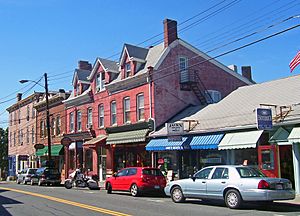
Buildings on downtown Main Street
|
|||
|
|||
| Etymology: From Palatine German pronunciation of Pfalz | |||
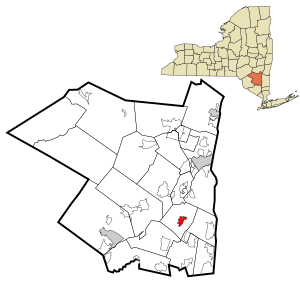
Location in Ulster County and the State of New York.
|
|||
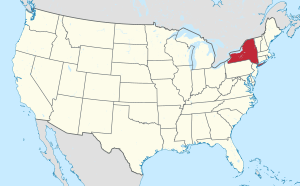
Location of New York in the United States
|
|||
| Country | |||
| State | |||
| County | Ulster | ||
| Founded | 1887 | ||
| Government | |||
| • Type | Village | ||
| • Body | Board of Trustees | ||
| Area | |||
| • Total | 1.80 sq mi (4.66 km2) | ||
| • Land | 1.76 sq mi (4.56 km2) | ||
| • Water | 0.04 sq mi (0.10 km2) | ||
| Highest elevation
(S village line near SE corner)
|
360 ft (110 m) | ||
| Lowest elevation
(Wallkill River at E village corner)
|
160 ft (50 m) | ||
| Population
(2020)
|
|||
| • Total | 7,324 | ||
| • Density | 4,156.64/sq mi (1,605.12/km2) | ||
| Time zone | UTC-5 (Eastern [EST]) | ||
| • Summer (DST) | UTC-4 (EDT) | ||
| ZIP Code(s) |
12561
|
||
| Area code(s) | 845 | ||
| FIPS code | 36-50551 | ||
| GNIS feature ID | 0958443 | ||
| Wikimedia Commons | New Paltz, New York | ||
| Website | village of New Paltz | ||
New Paltz is a village in Ulster County, New York. It is about 80 miles (129 km) north of New York City and 70 miles (113 km) south of Albany. In 2020, 7,324 people lived there.
New Paltz is part of the larger town of New Paltz. It is also home to the State University of New York at New Paltz. This university was started in 1828. You can reach the town from exit 18 on the New York State Thruway (I-87). State routes 299, 32, and 208 also pass through. New Paltz is about 90 minutes away from both New York City and Albany.
Contents
Exploring New Paltz History
New Paltz has many historic places. These include the Elting Memorial Library and the Jean Hasbrouck House. The Huguenot Street Historic District is also very important. These sites are listed on the National Register of Historic Places.
How New Paltz Began
New Paltz was founded in 1678 by French Huguenots. These were French Protestants who had to leave their home country. One of the founders was Louis DuBois. He and his family lived in Mannheim, Germany, for a short time. Mannheim was a big town in the Palatinate region, which was a center for Protestants.
In 1660, DuBois and his family moved to the Dutch colony of New Netherland. In 1677, the settlers bought land for New Paltz. They bought it from a Lenape tribe called the Esopus.
The people from Mannheim pronounced "Pfalz" as "Paltz." So, the settlement was named New Paltz. The first name for the community was Nouveau Palatinat, which is French. A group called the Duzine governed the community. This group was made up of the twelve partners who bought the land. This type of government continued even after the American Revolution.
The land bought was about 40,000 acres (16,187 hectares). It stretched to the Hudson River. This land was divided among the twelve partners, their families, and friends. The farms were mostly located near the Wallkill River. The main business area was on the east side of the Wallkill River. This is where the first settlers built their homes. Today, this street is known as Huguenot Street.
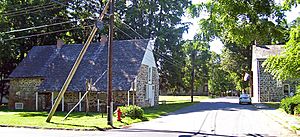
On Huguenot Street, the church, schools, and shops grew. Farmers could buy things like seeds, tools, and clothes there. The church was also used as a school. Many of these old buildings are still standing today. They are part of a living museum community.
Over time, people moved from the Wallkill River area. They settled along what is now North Front Street and Chestnut Street. In the 1800s, development continued along Main Street. The village of New Paltz was officially formed in 1887.
Education has been important in New Paltz since the 1830s. The college was built where the State University of New York at New Paltz is now.
The Wallkill Valley Railroad came to New Paltz by 1870. It carried passengers until 1937. After the railway closed in 1977, the tracks were turned into the Wallkill Valley Rail Trail. The old train station in New Paltz is now a restaurant called La Stazione.
New Paltz has many different restaurants. Some of them are highly rated. This makes New Paltz a popular place for people who enjoy good food.
Geography and Natural Features
New Paltz covers about 1.8 square miles (4.6 km²). Most of this area is land, about 1.7 square miles (4.5 km²). A small part, 0.04 square miles (0.1 km²), is water.
The Wallkill River flows north along the western edge of New Paltz. It eventually joins the Rondout Creek and then the Hudson River.
New Paltz Population Facts
| Historical population | |||
|---|---|---|---|
| Census | Pop. | %± | |
| 1870 | 425 | — | |
| 1880 | 493 | 16.0% | |
| 1890 | 935 | 89.7% | |
| 1900 | 1,022 | 9.3% | |
| 1910 | 1,230 | 20.4% | |
| 1920 | 1,056 | −14.1% | |
| 1930 | 1,362 | 29.0% | |
| 1940 | 1,492 | 9.5% | |
| 1950 | 2,285 | 53.2% | |
| 1960 | 3,041 | 33.1% | |
| 1970 | 6,058 | 99.2% | |
| 1980 | 4,938 | −18.5% | |
| 1990 | 5,463 | 10.6% | |
| 2000 | 6,034 | 10.5% | |
| 2010 | 6,818 | 13.0% | |
| 2020 | 7,324 | 7.4% | |
| U.S. Decennial Census 2020 | |||
In 2000, there were 6,034 people living in the village. There were 1,898 households. About 12.9% of these households had children under 18.
The average age in the village was 22 years old. Many people were between 18 and 24 years old (58.7%). For every 100 females, there were about 80.8 males.
Local News and Media
The first newspaper in New Paltz was the New Paltz Times. Charles J. Ackert started it on July 6, 1860. It was a weekly paper. Another newspaper, the New Paltz Independent, started in 1868.
The Times and Independent joined together in 1919. They became the New Paltz Independent and Times. This paper ran until 1972. Later, it was renamed the Old Dutch independent and stopped publishing in 1975.
The New Paltz News began in 1935. It merged with the Wallkill Valley World in 1980. The Huguenot Herald started in 1976. It merged with the Highland Herald in 1985.
At SUNY New Paltz, the college newspaper is the New Paltz Oracle. It was founded in 1938. In 2001, the Huguenot Herald and New Paltz News merged. They became the modern New Paltz Times. This paper is published every week.
New Paltz Culture and Events
New Paltz hosts many fun cultural events throughout the year.
Celebrating Diversity
Unity in Diversity Day
This event celebrates the many different kinds of people in New Paltz. It is supported by the village, town, and SUNY New Paltz. People enjoy food, poetry, art, and theater performances. In 2007, the theme was inspired by Dr. Seuss's story about Sneetches.
Halloween Fun in New Paltz
Haunted Hasbrouck Park
For over 25 years, the Guenther family created a free haunted house. It attracted thousands of visitors on Halloween night. After some concerns, the attraction moved to Hasbrouck Park in 2007. The park's castle playground became the center of the haunted house. Many local groups and volunteers helped with this event.
Halloween Parade
A Halloween parade has been held in the village since the 1960s. It's a fun tradition for everyone.
Haunted Huguenot Street Tours
Before Halloween, you can take "Haunted Huguenot Street" tours. These tours share stories of ghosts, sad events, and strange happenings. They take place on the 330-year-old street.
Night of 100 Pumpkins
Since 1990, a pumpkin-carving contest has been held at a local restaurant called The Bakery. It's called the "Night of 100 Pumpkins."
Other Community Events
Pride Parade
A pride parade celebrates LGBT culture in June. It brings many visitors to New Paltz. This is a special event because New Paltz was a place where same-sex weddings were performed even when they were not yet legal everywhere.
Memorial Day Parade
The local Memorial Day parade is always held on the actual Memorial Day. It does not move to the Monday holiday.
Turkey Trot
The Turkey Trot is a fundraising run held on Thanksgiving. It helps support the Family of New Paltz organization.
New Paltz Regatta
The New Paltz Regatta is a river race with homemade boats. It started in 1955 by the Delta Kappa fraternity at SUNY New Paltz. Now, local citizens organize it every May. It celebrates the start of summer.
New Paltz in Stories
- The town is mentioned in Paul Simon's song "Killer Wants to Go To College." This song is on his album Songs from The Capeman.
- New Paltz was called "Little Heart" in the 2013 novel The Cusp of Sad. This book by Nikki Pison is about the punk rock scene in the 1980s.
Fun Activities and Recreation
Biking and Hiking Trails
The Mohonk Preserve, Mohonk Mountain House, and Minnewaska State Park offer great places for biking and hiking. These areas are known for their beautiful scenery.
The Wallkill Valley Rail Trail goes through New Paltz. Part of it also runs along the Empire State Trail.
Getting Around New Paltz
Travel by Car
New Paltz is located at exit 18 on the New York State Thruway. This road is also known as Interstate 87.
Bus Services
You can find frequent bus service between the Port Authority Bus Terminal in New York City and New Paltz. Trailways of New York provides these buses. They also connect to many other towns and cities in New York State.
Express bus service is also available from New Paltz to New York City. Ulster County Area Transit offers bus service to Metro-North Railroad in Poughkeepsie. They also have local buses to Kingston, Newburgh, and other places along Route 32. In 2009, the New Paltz Loop Bus started. It stops at different places throughout the community.
Air Travel
Stewart International Airport is the closest major airport to New Paltz. It is in Newburgh, about 30 minutes south of the village.
Train Connections
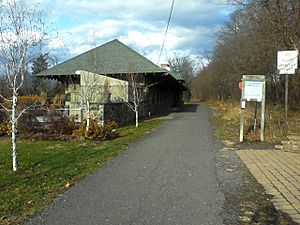
The Wallkill Valley Railroad was founded in 1866. It ran from Montgomery to Kingston. The New Paltz train station was built in 1870. It was rebuilt after a fire in 1907.
The railroad later became part of New York Central. They ran two trains a day between Kingston, New Paltz, and Montgomery. In Kingston, you could connect to trains going north to Albany or south to Weehawken, New Jersey. Passenger service through New Paltz stopped in 1937. The rail line was closed in 1983. The old tracks were then turned into the Wallkill Valley Rail Trail.
The old station building (now called La Stazione) was sold in 1959. It was in bad shape by the early 1980s. But it was fixed up in 1988 and became an Italian restaurant in 1999.
The closest active train station is the Poughkeepsie Metro-North station. Several Amtrak trains stop there. It is also the end point for the Metro-North Railroad's Hudson Line. This line goes from Poughkeepsie to Grand Central Terminal in New York City. Poughkeepsie is about a 15-20 minute drive east of New Paltz.
Education in New Paltz
The village is part of the New Paltz Central School District.
Famous People from New Paltz
- Louis Dubois, who helped found one of the first Huguenot settlements in America.
- Abe Attell, a boxing champion.
- Lewis DuBois, a descendant of the original Huguenot settlers and a military leader in the Continental Army.
- Mary Gordon, a novelist.
- Peter Dinklage, a famous actor.
- John Turturro, a Hollywood actor.
- Sandy Duncan, an actor known for Broadway theatre and television.
- Floyd Patterson, a heavyweight boxing champion.
- Andrew Yang, founder of Venture for America and a 2020 candidate for U.S. president.
- Owen King, an author and son of Stephen King.
Sister City
See Also
 In Spanish: New Paltz (villa) para niños
In Spanish: New Paltz (villa) para niños



